Dear Zazie, Here is today’s Lovers’ Chronicle™ from Mac Tag dedicated to his muse. Rhett
The Lovers’ Chronicle
Dear Muse,
i god 2021
what a year
begun in the arms
of belongin’ with
hope ridin’ shotgun
as the year progressed,
comin’ together, came
a gift, we gave each other
that opened and bloomed
and became what matters
now look where it ended
where it was meant to
© copyright 2021 mac tag/cowboy coleridge all rights reserved
© copyright 2020 mac tag/cowboy coleridge all rights reserved
i god 2019
what a year
i know where it started
still tryin’ to process
where it ended
as you know,
began without
holdin’ nothin’
but verse
and now,
here with you
nine and a half
years later
holdin’ you
what i waited for,
what i wanted
for so long
with you
i am amazed
© Copyright 2019 Mac tag/cowboy coleridge all rights reserved
i god, 2018
what a year
another
stressful one
it was the best
of times
it was the worst…
oh wait, that
has already
been written
it will go down,
for now anyway,
as the time
it was decided
that this
is the only
true way to be
it began
with a question
and ends
with an answer
if not you,
then this
2018
it was the best
of times
it was the worst…
oh wait, that
has already been written
helluva year
much have i told you,
much i have not
suffice to say,
i got by
thanks in part
to a lotta help
from my friends
“I get by
with a little help…”
thank you friends
may 2019
hold for you
all that you would have
© copyright 2018 mac tag/cowboy coleridge all rights reserved
i god, 2017
what a year
what i knew
would happen
finally did
only cost
one heart attack,
fourteen years,
and a lotta money
but it was worth it
to be where i should be
new year’s eve, alone
with the twilight zone
and champagne
Cheers, Santé,
Sláinte, Salute,
¡Salud!, Prosit,
to 2018,
to you
may the new year
be more
than we can dream
2017
ends in a better place
than it began
thanks in part
to a lotta help
from my friends,
new and old
“i git by
with a little help
from my friends”
thank you friends
© copyright 2017 mac tag/cowboy coleridge all rights reserved
i god, 2016
what a year
the stress finally
became too much
this cold, cold heart
tried to stop beatin’
i know, i know,
some thought
i had not a heart
thankful to still
be here, but so
is the stress
hopeful i will
be writin’ to you
this time next year
© copyright 2016 mac tag/cowboy coleridge all rights reserved
The letters he wrote to her,
his only remedy to keep
from goin’ mad or dyin’ of regret…
He took the course
of least resistance
Puttin’ himself in a position
where he need no longer go
without any necessities of life
Just what those necessities were
for him, no one could judge….
No one could understand
how an intimacy
could exist between him
and the woman in Wyoming
He a man of known character,
her strong in her commitment
to her way of life,
her land and livestock,
he attracted to every kind
of impermanence
But then he met Jolie
A woman of beauty,
intelligence, and culture
Of her he said,
those who believe that a woman
is incapable of makin’ a man
equally happy all the twenty-four
hours of the day have never
known a Jolie
She turned him on
to opera and French poetry
He turned her on
to campfires and first light
No woman so captivated
him as she did
Only one other obtained
so deep an understandin’ of him
She penetrated his outward
shell early on in their relationship
But Jolie resisted the temptation
to join her destiny with his
She came to discern
his wanderin’ nature,
and the precariousness
of his feelin’s
Before leavin’,
she slipped a letter into his pocket
He would not speak of what it said
Crestfallen, despondent,
he returned to Wyoming,
to the woman
who waited patiently for him
She welcomed him
knowin’ full well
he would wander again
And so it was,
after a lucky gamblin’ streak,
he recovered
and set off for a tour of France,
and Italy
Along the way,
from one town, from one heart,
to another,
he engaged in sexual escapades
resemblin’ operatic plots
He settled in Venice,
learned the language,
and wrote verse
and letters to the one
he came to understand,
he should return to
© copyright 2016 mac tag/cowboy Coleridge all rights reserved
 On this day in 1759 – Arthur Guinness signs a 9,000 year lease at £45 per annum and starts brewing Guinness. Raise a glass to our favorite beer!
On this day in 1759 – Arthur Guinness signs a 9,000 year lease at £45 per annum and starts brewing Guinness. Raise a glass to our favorite beer!

Marie d’Agoult (1843), painting by Henri Lehmann.
Today is the birthday of Marie Catherine Sophie, Comtesse d’Agoult (Frankfurt am Main, Germany 31 December 1805 – 5 March 1876 Paris); romantic author, known also by her pen name, Daniel Stern.
She entered into an early marriage of convenience with Charles Louis Constant d’Agoult, Comte d’Agoult (1790–1875) on 16 May 1827, thereby becoming the Comtesse d’Agoult. They were divorced on 19 August 1835.
From 1835 to 1839, she lived with virtuoso pianist and composer Franz Liszt, who was six years younger, and was then a rising concert star. She became close to Liszt’s circle of friends, including Frédéric Chopin, who dedicated his 12 Études, Op. 25 to her. D’Agoult had three children with Liszt; however, she and Liszt did not marry, maintaining their independent views and other differences while Liszt was busy composing and touring throughout Europe.

Portrait de Marie d’Agoult par Théodore Chassériau (Musée du Louvre)
She died in Paris, aged 70, and was buried in Division 54 of Père Lachaise Cemetery.
She was portrayed by Geneviève Page in the 1960 film Song Without End, opposite Dirk Bogarde as Liszt; by Klara Luchko in the 1970 film Szerelmi álmok – Liszt, by Fiona Lewis; in the 1975 Ken Russell film Lisztomania, opposite Roger Daltrey as Liszt; and by Bernadette Peters in the 1991 James Lapine film Impromptu, which last dramatized encounters between d’Agoult, Liszt (Julian Sands), Chopin (Hugh Grant), and George Sand (Judy Davis).

d’Agoult in 1861. Photo by Adam-Salomon.
Her first stories (Hervé, Julien, and Valentia) were published in 1841-1845. Perhaps her best-known work (written as “Daniel Stern”) is the Histoire de la révolution de 1848 (appearing from 1850–53, in 3 volumes). D’Agoult’s other works include the novel Nélida (1846), Lettres Républicaines in Esquisses morales et politiques (1849, collected articles), Trois journées de la vie de Marie Stuart (1856), Florence et Turin (1862), Histoire des commencements de la république aux Pays-Bas (1872), “A Catholic Mother Speaks to Her Children” (1906, posthumously), and Mes souvenirs (1877, posthumously).
Portrait head of Alexander Smith on his grave, Warriston Cemetery, Edinburgh
Today is the birthday of Alexander Smith (Kilmarnock 31 December 1830 – 5 January 1867 Edinburgh); poet, labelled as one of the Spasmodic School, and essayist.
On 24 April 1857 Smith married Flora Macdonald (1829/30–1873) at Ord House on the Isle of Skye. The couple had to return to Edinburgh soon after the wedding (via a steamer trip to Oban), but it was to Skye that they would return every August for the nine remaining years of the poet’s life. These visits, as well as providing the raw material for his best-known work, were to prove essential to sustaining his creativity.
Verse
- We hear the wail of the remorseful winds
In their strange penance. And this wretched orb
Knows not the taste of rest; a maniac world,
Homeless and sobbing through the deep she goes.
- Unrest and Childhood.
- The soul of man is like the rolling world,
One half in day, the other dipt in night;
The one has music and the flying cloud,
The other, silence and the wakeful stars. - Horton.
- Time has fallen asleep in the afternoon sunshine.
- Dreamthorp: Essays written in the Country (1863).
- The man who in this world can keep the whiteness of his soul is not likely to lose it in any other.
- Dreamthorp: Essays written in the Country (1863).
A Life Drama and other Poems (1853)
- Like a pale martyr in his shirt of fire.
- Scene 2.
- In winter, when the dismal rain
Comes down in slanting lines,
And Wind, that grand old harper, smote
His thunder-harp of pines.
- Scene 2.
- A poem round and perfect as a star.
- Scene 2.
- Some books are drenchèd sands
On which a great soul’s wealth lies all in heaps,
Like a wrecked argosy.
- Scene 2.
- The saddest thing that befalls a soul
Is when it loses faith in God and woman.
- Scene 12.
- We twain have met like the ships upon the sea,
Who hold an hour’s converse, so short, so sweet;
One little hour! And then, away they speed
On lonely paths, through mist and cloud and foam,
To meet no more.
- Part iv.
City Poems (1857)
- Each time we love,
We turn a nearer and a broader mark
To that keen archer, Sorrow, and he strikes.
- “A Boy’s Dream”.
- Death is the ugly fact which Nature has to hide, and she hides it well.
- “The Fear of Dying”.
- Everything is sweetened by risk.
- “The Fear of Dying”.
- In life there is nothing more unexpected and surprising than the arrivals and departures of pleasure. If we find it in one place to-day, it is vain to seek it there to-morrow. You can not lay a trap for it.
- “The Fear of Dying”.
| Giovanni Boldini | |
|---|---|

Photographic portrait of Giovanni Boldini (1910) |
|
Today is the birthday of Giovanni Boldini (Ferrara 31 December 1842 – 11 July 1931 Paris); genre and portrait painter who lived and worked in Paris for most of his career. According to a 1933 article in Time magazine, he was known as the “Master of Swish” because of his flowing style of painting.
A Boldini portrait of his former muse Marthe de Florian, a French actress, was discovered in a Paris flat in late 2010, hidden away from view on the premises that were unvisited for 70 years. The portrait has never been listed, exhibited or published and the flat belonged to de Florian’s granddaughter who went to live in the South of France at the outbreak of the Second World War and never returned. A love-note and a biographical reference to the work painted in 1888, when the actress was 24, proved its authenticity. A full-length portrait of the lady in the same clothing and accessories, but less provocative, hangs in the New Orleans Museum of Art. The discovery of this painting forms the background to Michelle Gable’s 2014 novel A Paris Apartment.
Gallery

Self-portrait at Montorsoli, (1892), Florence, Uffizi Gallery, Vasari Corridor
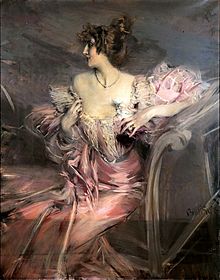
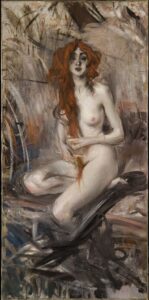
-

Portrait (1897) of French poet, writer and dandy, comte Robert de Montesquiou (1855-1921)
-

Portrait of opera singer Lina Cavalieri
-

Canale a Venezia con gondole (Art collections of Fondazione Cariplo)
-

Madame Michelham, 1913
-

Portrait de Madame E, 1892 National National Museum of Decorative Arts Buenos Aires
-

”Portrait of a Lady”, 1912 Brooklyn Museum
| Giovanni Pascoli | |
|---|---|
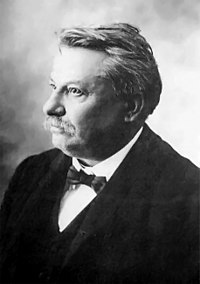 |
|
|
|
Today is the birthday of Giovanni Placido Agostino Pascoli (San Mauro Pascoli; December 31, 1855 – April 6, 1912 Bologna); poet and classical scholar.
Ed ella avvolse l’uomo nella nube
dei suoi capelli; ed ululò sul flutto
sterile, dove non l’udia nessuno:
– Non esser mai! non esser mai! più nulla,
ma meno morte, che non esser più! –
Io vedo (come è questo giorno, oscuro!),
vedo nel cuore, vedo un camposanto
con un fosco cipresso alto sul muro.
E quel cipresso fumido si scaglia
allo scirocco: a ora a ora in pianto
sciogliesi l’infinita nuvolaglia.
| Henri Matisse | |
|---|---|
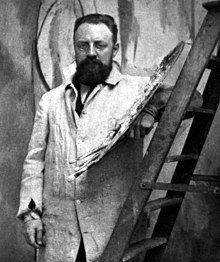
Henri Matisse, 1913, by Alvin Langdon Coburn |
|
And today is the birthday of Henri-Émile-Benoît Matisse (Le Cateau-Cambrésis, Nord; 31 December 1869 – 3 November 1954 Nice); artist, known for both his use of colour and his fluid and original draughtsmanship. He was a draughtsman, printmaker, and sculptor, but is known primarily as a painter.
Matisse is commonly regarded, along with Pablo Picasso and Marcel Duchamp, as one of the three artists who helped to define the revolutionary developments in the plastic arts throughout the opening decades of the twentieth century, responsible for significant developments in painting and sculpture. Although he was initially labelled a Fauve (wild beast), by the 1920s he was increasingly hailed as an upholder of the classical tradition in French painting. His mastery of the expressive language of colour and drawing, displayed in a body of work spanning over a half-century, won him recognition as a leading figure in modern art.
With the model Caroline Joblau, he had a daughter, born in 1894. In 1898 he married Amélie Noellie Parayre.
Matisse’s wife Amélie, who suspected that he was having an affair with her young Russian emigre companion, Lydia Delectorskaya, ended their 41-year marriage in July, 1939, dividing their possessions equally between them. Delectorskaya attempted suicide by shooting herself in the chest. She survived with no serious after-effects, and instead returned to the now-single Matisse and worked with him for the rest of his life, running his household, paying the bills, typing his correspondence, keeping records, assisting in the studio and coordinating his business affairs.
In 1941, a nursing student named Monique Bourgeois responded to an ad placed by Matisse for a nurse. A friendship developed between Matisse and Bourgeois. He discovered that she was an amateur artist, and taught her about perspective. After Bourgeois left the position to join a convent in 1944, Matisse sometimes contacted her to request that she model for him. Bourgeois became a Dominican nun in 1946, and Matisse painted a chapel in Vence, a small town he moved to in 1943, in her honor.
Matisse died of a heart attack at the age of 84 on 3 November 1954. He is interred in the cemetery of the Monastère Notre Dame de Cimiez, near Nice.
Gallery

Henri and Amélie Matisse, 1898

Woman Reading, 1894, Museum of Modern Art, Paris
-

Gustave Moreau’s Studio, 1894-1895
-
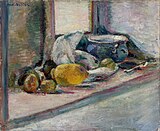
Blue Pot and Lemon (1897), Hermitage Museum, St. Petersburg, Russia
-

Le Mur Rose, 1898, Jewish Museum Frankfurt
-

Fruit and Coffeepot (1898), Hermitage Museum, St. Petersburg, Russia
-

Vase of Sunflowers (1898), Hermitage Museum, St. Petersburg, Russia
-

Study of a Nude, 1899, Bridgestone Museum of Art, Tokyo
-

Still Life with Compote, Apples and Oranges, 1899, The Cone Collection, Baltimore Museum of Art
-

Crockery on a Table (1900), Hermitage Museum, St. Petersburg, Russia
Fauvism
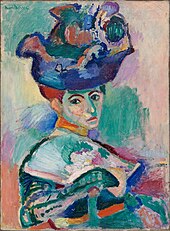
Woman with a Hat, 1905. San Francisco Museum of Modern Art

Les toits de Collioure, 1905, oil on canvas, The Hermitage, St. Petersburg, Russia
-
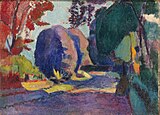
Luxembourg Gardens, 1901, Hermitage Museum, St. Petersburg, Russia
-
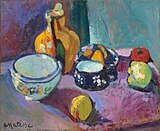
Dishes and Fruit, 1901, Hermitage Museum, St. Petersburg, Russia
-
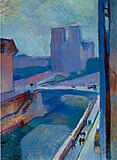
A Glimpse of Notre-Dame in the Late Afternoon, 1902, Albright-Knox Art Gallery, Buffalo, New York
-

Nu (Carmelita), 1904, Museum of Fine Arts, Boston
-

Luxe, Calme et Volupté, 1904, Musée d’Orsay, Paris, France
-
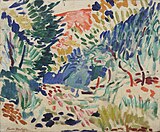
Landscape at Collioure, 1905, Museum of Modern Art
-
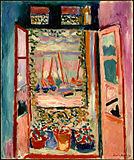
Open Window, Collioure, 1905, National Gallery of Art, Washington, D.C.
-
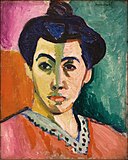
Portrait of Madame Matisse (The green line), 1905, Statens Museum for Kunst, Copenhagen, Denmark
-
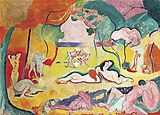
Le bonheur de vivre, 1905–6, Barnes Foundation
-

Self-Portrait in a Striped T-shirt 1906, Statens Museum for Kunst, Copenhagen, Denmark
-

The Young Sailor II, 1906, Metropolitan Museum of Art, New York City
-

Vase, Bottle and Fruit, 1906, Hermitage Museum, St. Petersburg, Russia
-
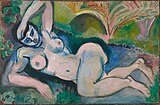
Blue Nude, 1907, Baltimore Museum of Art
-
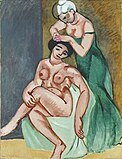
La coiffure, 1907, Staatsgalerie Stuttgart
-
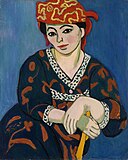
Madras Rouge, The Red Turban, 1907, Barnes Foundation. Exhibited at the 1913 Armory Show
-
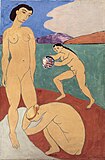
Le Luxe II, 1907–08, Statens Museum for Kunst, Copenhagen
-

Les trois baigneuses (Three Bathers), 1907, The Minneapolis Institute of Arts
-
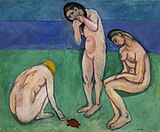
Bathers with a Turtle, 1908, Saint Louis Art Museum, St. Louis
-
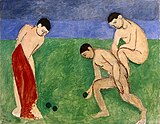
Game of Bowls, 1908, Hermitage Museum, St. Petersburg, Russia
-

The Dance (first version), 1909, The Museum of Modern Art, New York City
-

Still Life with Dance, 1909, Hermitage Museum, Saint Petersburg
-
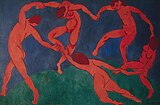
The Dance, 1910, Hermitage Museum, St. Petersburg, Russia
-

Les Capucines (Nasturtiums with The Dance II), 1910–12, Pushkin Museum
-

Music, 1910, Hermitage Museum, St. Petersburg, Russia

Red Room (Harmony in Red) (1908)

Matisse in Paris, 13 August 1913. Photograph by Carl Van Vechten

The Moroccans, 1915-16, oil on canvas, 181.3 x 279.4 cm, Museum of Modern Art
-

Still Life with Geraniums, 1910, Pinakothek der Moderne, Munich, Germany
-

L’Atelier Rouge, 1911, The Museum of Modern Art, New York City
-

The Conversation, c.1911, The Hermitage, St. Petersburg, Russia
-

Window at Tangier, 1911-12, The Pushkin Museum of Fine Arts, Moscow
-
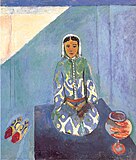
Zorah on the Terrace, 1912, The Pushkin Museum of Fine Arts, Moscow, Russia
-
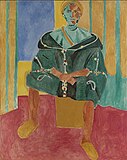
Le Rifain assis, 1912–13, 200 × 160 cm. Barnes Foundation
-
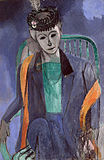
Portrait of the Artist’s Wife, 1913, Hermitage Museum, Saint Petersburg
-

La glace sans tain (The Blue Window), 1913, Museum of Modern Art
-

Woman on a High Stool, 1914, Museum of Modern Art, New York City
-
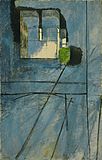
View of Notre-Dame, 1914, Museum of Modern Art
-

Les poissons rouges (Interior with a Goldfish Bowl), Musée National d’Art Moderne, Centre Georges Pompidou, Paris
-

French Window at Collioure, 1914. Musée National d’Art Moderne, Paris
-

The Yellow Curtain, 1915, Museum of Modern Art, New York
-

Auguste Pellerin II, 1916–17, Musée National d’Art Moderne, Paris
-
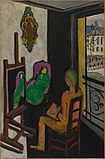
The Painter and His Model (Le Peintre dans son atelier), 1916–17, Musée National d’Art Moderne, Paris
-

Three Sisters and The Rose Marble Table (Les Trois sœurs à La Table de marbre rose), 1917, Barnes Foundation, Philadelphia
-

Portrait de famille (The Music Lesson), 1917, oil on canvas, 245.1 x 210.8 cm, Barnes Foundation

Odalisque with Arms Raised, (of Henriette Darricarrière), 1923, National Gallery of Art, Washington, D.C.

Self-portrait, 1918, Matisse Museum (Le Cateau)

Annelies, White Tulips and Anemones 1944

The Snail, 1953, Gouache on paper, cut and pasted, on white paper, collection Tate Modern
Cover of Jazz

The Plum Blossoms, 1948, Museum of Modern Art, NYC
Mac Tag



No Comments on "The Lovers’ Chronicle 31 December – old long since – birth of Marie d’Agoult – verse by Alexander Smith & Giovanni Pascoli – art by Giovanni Boldini & Matisse"